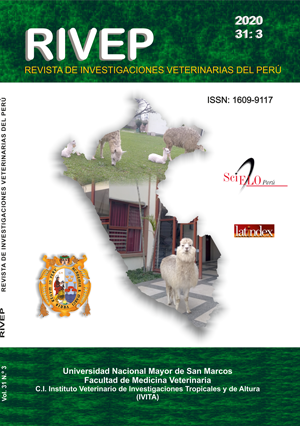Optimization of a protocol for cryopreservation of the spermatophore and sperm mass of the whteleg shrimp Litopenaeus vannamei (Boone, 1931)
DOI:
https://doi.org/10.15381/rivep.v31i3.17101Keywords:
Cryopreservation, spermatophore, sperm mass, Litopenaeus vannameiAbstract
The effect of six cryoprotective solutions based on MgCl2 and methanol, in addtion with sucrose and 10% Aloe vera gel or 10% egg yolk, on the sperm viability in spermatophore and sperm mass of Litopenaeus vannamei was evaluated. Besides, cooling rates of -0.5, -1 and -2 °C/min were used until temperature reached -35, -80 and -100 °C prior to immersion in liquid nitrogen. The sperm viability rate was determined by eosin-nigrosin staining. The results showed that the solutions based on MgCl2, sucrose plus egg yolk or Aloe vera gel better preserved sperm viability in spermatophore (82.8 ± 2.3% and 72.6 ± 3.1%) and in sperm mass (83.4 ± 2.5% and 76 ± 1.1%) without significant differences with the control group (p>0.05). The freezing curve showing less damage in spermatophore started from 25 °C and reached -35 °C with a rate of -1 °C/min using a cryoprotective solution with egg yolk and MgCl2, showing a sperm viability greater than 80% without significant differences with the control group (p>0.05), and a rate of -2 °C/min in the same temperature range for the group with sperm mass and a solution based on Aloe vera gel. In conclusion, the use of a solution based of MgCl2, sucrose, Aloe vera gel or egg yolk and at a cooling rate of -1 °C/min or -2 °C/min until reaching -35 °C allows a successful freezing of spermatophores or sperm of Litopenaeus vannamei.
Downloads
Downloads
Published
Issue
Section
License
Copyright (c) 2020 Luz Fernanda Dominguez Mendoza, Carlos Alberto Torres Pera, Max Salvatierra Alor, Emmerik Motte D., Juan Gerardo Quimi Mujica, Martha Esther Valdivia Cuya, María Isabel Solis Loza, Yovani Luzmila Rosales Maceda, Juan Vicente Luzardo Solis, Eric Mialhe M.

This work is licensed under a Creative Commons Attribution-NonCommercial-ShareAlike 4.0 International License.
AUTHORS RETAIN THEIR RIGHTS:
a. Authors retain their trade mark rights and patent, and also on any process or procedure described in the article.
b. Authors retain their right to share, copy, distribute, perform and publicly communicate their article (eg, to place their article in an institutional repository or publish it in a book), with an acknowledgment of its initial publication in the Revista de Investigaciones Veterinarias del Perú (RIVEP).
c. Authors retain theirs right to make a subsequent publication of their work, to use the article or any part thereof (eg a compilation of his papers, lecture notes, thesis, or a book), always indicating the source of publication (the originator of the work, journal, volume, number and date).










